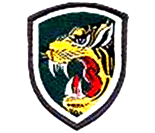Capital Mechanized Infantry Division (Republic of Korea)
| Capital Division | |
|---|---|
 |
|
| Active | 20 June 1948 - present |
| Country |
|
| Branch |
|
| Type | Mechanized infantry |
| Role | Offensive force |
| Part of | VII Corps |
| Nickname(s) | Maengho (Tiger) |
| Engagements |
Korean War Vietnam War |
| Commanders | |
| Notable commanders |
Lt. Gen. Chae Myung-shin |
The Capital Mechanized Infantry Division (hangul: 수도기계화보병사단; hanja:首都機械化步兵師團), also known as Tiger Division (hangul:맹호사단; hanja:猛虎師團), is currently one of the six mechanized infantry divisions in the Republic of Korea Army. It is part of the VII Corps, 3rd ROK Army (TROKA), tasked with covering approaches to Seoul from North Korea and counterattack operations.
This division saw extensive combat both during the Korean War and the Vietnam War, where it was dispatched in September 1965, as a part of the Republic of Korea's contribution to the South Vietnamese war effort. The 1965 deployment became possible when in August of that year the Republic of Korea's National Assembly passed a bill authorizing the action. Recently, elements of this division were sent as Republic of Korea's contribution to the "coalition of the willing" in Iraq.
The Capital Division was a military formation of the Republic of Korea Army during the 20th Century. It was formed June 20, 1948 from the Capital Security Command. It was incorporated into I Corps after the first fall of Seoul, soon becoming part the defensive line formed in an attempt to slow the North Korean advance to Taejon. It later participated in the Battle of Pusan Perimeter.
On September 16, 1950, elements of the Capital Division fought their way through the streets of Angang-ni. The next day, advancing from the west in the II Corps sector, a battalion of the 7th Division linked up with elements of the Capital Division, closing a two-week-old gap between the ROK I and II Corps. The NKPA’s 12th Division waged a series of stubborn delaying actions against the Capital Division in the vicinity of Kigye as the North Koreans retreated northward into the mountains. Kigye fell back under South Korean control on September 22, 1950.
...
Wikipedia
